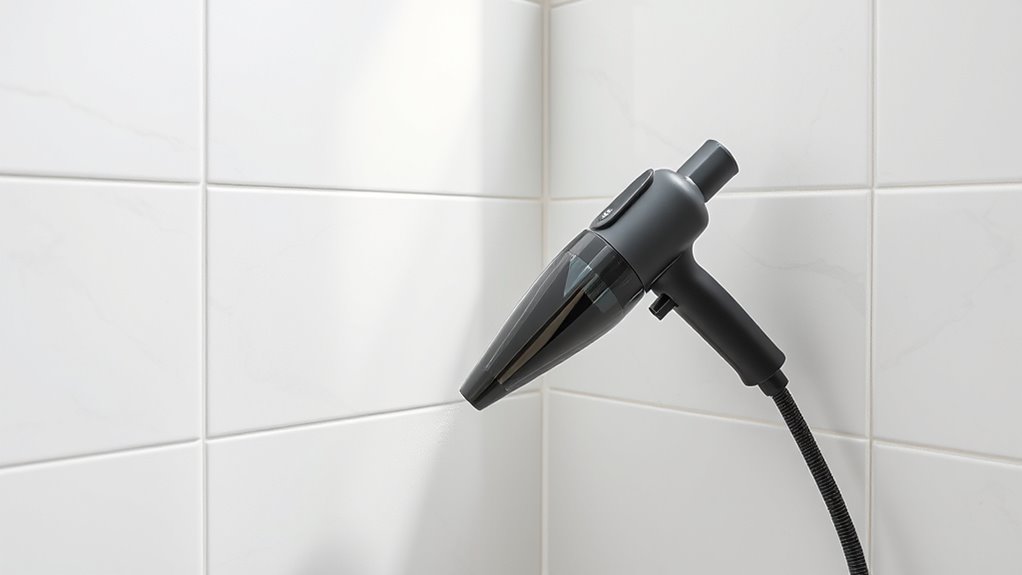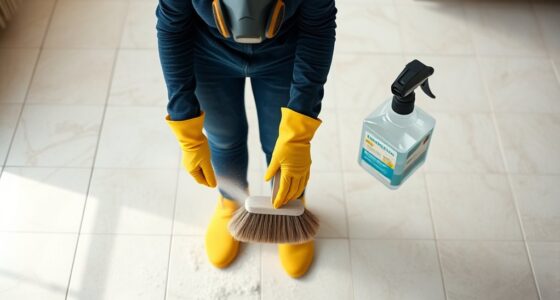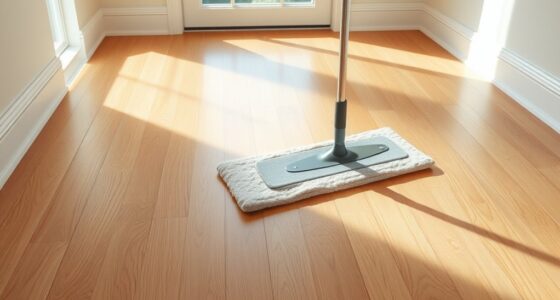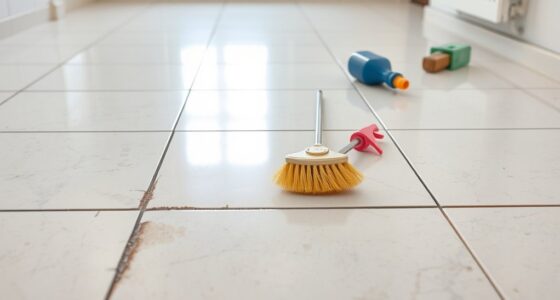To keep your grout lines allergy-safe, vacuum regularly using a brush attachment to gently loosen dust and debris, focusing on edges and corners. Use a high-quality filter to trap small particles and prevent dust from recirculating. After vacuuming, apply a grout sealer to create a barrier that prevents dust from settling into porous surfaces. Consistent cleaning combined with sealing reduces dust buildup and improves indoor air quality; discover more effective techniques ahead.
Key Takeaways
- Regularly vacuum grout lines with a brush attachment to remove dust buildup safely.
- Use high-quality filters in your vacuum to trap tiny dust particles and improve indoor air quality.
- Seal grout lines with a proper sealer to create a barrier against dust infiltration and ease cleaning.
- Avoid harsh chemicals; opt for gentle cleaning methods to prevent dust from becoming airborne.
- Maintain a routine of vacuuming and resealing grout every few years for long-term allergy-safe dust control.

Dust accumulation on grout lines can quickly become a frustrating problem, especially in areas with high foot traffic or ongoing renovation work. It seems like no matter how often you clean, dust finds its way into every crevice, making your space look dull and dirty. The good news is, you can considerably reduce this buildup by mastering effective vacuum techniques and applying proper sealing methods. These strategies not only keep your grout lines cleaner longer but also create a healthier environment, especially for allergy sufferers.
When it comes to vacuum techniques, the key is to use tools designed for detailed cleaning. A vacuum cleaner with a brush attachment or a crevice tool can make a huge difference. You want to get as close to the grout lines as possible without damaging the tiles. Use slow, deliberate strokes to loosen and lift dust from the surface and deep within the grout. Don’t just run the vacuum over the area; spend extra time focusing on the edges and corners, where dust tends to settle. Regular vacuuming prevents dust from settling into the porous grout, making your cleaning routine more effective and less time-consuming. Additionally, high-quality vacuum filters can trap smaller dust particles, preventing them from recirculating into the air.
Use a brush attachment and slow strokes for detailed grout cleaning without damage.
Sealing methods are equally important in controlling dust. Grout sealing acts as a barrier that prevents dust, dirt, and moisture from penetrating the porous surface. After thoroughly cleaning and allowing the grout to dry, apply a high-quality grout sealer according to the manufacturer’s instructions. Make sure to cover every inch of the grout lines, using a small brush or applicator for precision. Once sealed, the grout becomes less receptive to dust particles, which means less frequent deep cleanings and a cleaner appearance overall. Reapply the sealer every couple of years or as recommended, especially in high-traffic areas.
Combining these two approaches creates a robust barrier against dust buildup. Regular vacuuming with proper technique keeps surface dust at bay, while sealing minimizes dust infiltration into the grout itself. Together, they form an effective, allergy-safe routine that’s easy to maintain. Remember, consistency is key. Incorporate vacuuming into your weekly cleaning schedule, and reseal your grout whenever it shows signs of wear. This proactive approach reduces dust accumulation, enhances the lifespan of your tiles, and creates a healthier living environment. By taking these simple steps, you’ll find that keeping grout lines clean and dust-free becomes much more manageable, making your space more comfortable and allergy-friendly.
Frequently Asked Questions
What Are the Best Natural Remedies for Grout Dust Allergies?
You can try herbal remedies like chamomile or peppermint tea bags to soothe allergy symptoms. Essential oils such as eucalyptus or tea tree oil may help clear your airways when diffused. Regularly cleaning grout lines with a damp cloth reduces dust buildup. Using natural remedies like herbal teas and essential oils can ease allergy symptoms, but always test for sensitivity and consult with a healthcare professional before trying new treatments.
How Often Should I Clean Grout Lines to Prevent Dust Buildup?
Think of grout maintenance like tending a garden; regular care prevents dust accumulation. You should clean your grout lines at least once a week to keep dust buildup at bay. Use a gentle brush and a mild, allergy-safe cleaner to scrub away dirt, mold, and dust. Consistent cleaning not only maintains a fresh appearance but also creates a healthier environment, reducing allergy triggers and keeping your space comfortable.
Are There Specific Tools Recommended for Allergy-Safe Grout Dust Removal?
You should use vacuum attachments designed for delicate surfaces to effectively remove dust from grout lines without spreading allergens. Pair this with a microfiber cloth for a thorough clean and to pick up residual dust. These tools are allergy-safe, easy to handle, and gentle on your grout. Regularly using a vacuum with appropriate attachments and microfiber cloths guarantees minimal dust buildup, creating a healthier environment for allergy sufferers.
Can Sealing Grout Lines Reduce Dust and Allergen Accumulation?
Sealing grout lines acts like a protective shield, much like a raincoat keeps you dry. It offers sealing benefits by creating a barrier that prevents dust and allergens from settling into the grout cracks. This simple step greatly reduces dust prevention, making your space more allergy-safe. Regular sealing helps maintain a cleaner environment, ensuring fewer irritants linger and your home stays healthier for everyone.
What Precautions Should Children Take Around Dusty Grout Lines?
You should guarantee children avoid dusty grout lines by implementing child-proofing measures like sealing grout to reduce dust. Use dust barrier techniques, such as plastic sheeting or covers, to contain dust and prevent inhalation. Supervise kids closely around these areas, and encourage them to wash hands afterward. Regular cleaning and maintaining sealed grout can markedly decrease allergen exposure, creating a safer environment for children.
Conclusion
By regularly dusting and sealing your grout lines, you keep dust and allergens at bay, creating a healthier home environment. Some might think it’s a tedious task, but imagine your grout lines as a clean, clear pathway—no dust buildup blocking your way. With consistent effort, you’ll notice fresher air and fewer allergy symptoms. So, embrace this simple routine; it’s a small step for your grout, but a giant leap for your allergy relief.









